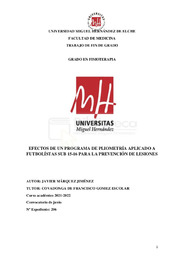Por favor, use este identificador para citar o enlazar este ítem:
https://hdl.handle.net/11000/28140Registro completo de metadatos
| Campo DC | Valor | Lengua/Idioma |
|---|---|---|
| dc.contributor.advisor | De Francisco Gómez Escolar, Covadonga | - |
| dc.contributor.author | Márquez Jiménez, Javier | - |
| dc.contributor.other | Departamentos de la UMH::Patología y Cirugía | es_ES |
| dc.date.accessioned | 2022-10-31T09:49:12Z | - |
| dc.date.available | 2022-10-31T09:49:12Z | - |
| dc.date.created | 2022-06-20 | - |
| dc.identifier.uri | https://hdl.handle.net/11000/28140 | - |
| dc.description.abstract | Tras la observación de la inexistencia del trabajo pliométrico en edades inferiores del Hércules CF se llevó a cabo un formulario a los entrenadores y preparadores, para posteriormente realizar una intervención. Este trabajo consiste en un estudio de campo basado en un programa de pliometría para futbolistas cadetes del Hércules Club de Fútbol que tuvo como objetivo demostrar los efectos que tienen los ejercicios pliométricos para la prevención de lesiones en miembros inferiores mediante la realización de saltos verticales y horizontales. La muestra se realizó con 31 jugadores, de los cuales 15 estuvieron en el grupo control (cadete A) y los otros 16 en el grupo experimental (cadete B). Se realizaron los test de Salto Contramovimiento (CMJ) y Triple salto (THT) antes y después del programa. El estudio se basó en un programa de entrenamiento que se desarrolló durante 6 semanas, con 1 sesión de ejercicio por semana, la cual evolucionó cada 2 semanas, aumentando el volumen e intensidad. Los resultados obtenidos, afirman que este entrenamiento tiene un efecto positivo en reducir el riesgo lesional cuando se realiza un trabajo pliométrico. En concreto, se obtuvo una mejora de 7,87% de media en el test CMJ. Por otro lado, en el THT se obtuvieron mejoras de un 5,00% en la pierna dominante y un 5,59% en la pierna no dominante. Sin embargo, el índice de simetría (IS) entre la pierna dominante frente a la no dominante fue más o menos similar, pero disminuyó un 0,46%. Como pudimos observar y analizar, se vieron mejoras tanto en el salto vertical como en el salto horizontal. Por tanto, se demostró que los ejercicios pliométricos son importantes durante el entrenamiento en estas edades porque mejoran la fuerza, el rendimiento, disminuye las asimetrías entre la pierna dominante frente a la no dominante y previene futuras lesiones. | es_ES |
| dc.description.abstract | Once the lack of polymetric work has been analysed in the youth teams of Hercules CF, a form on plyometrics has been carried out for both coaches and fitness coaches to perform an intervention on these teams. This study consists of an analysis based on a plyometric programme focused on the prevention of injuries in youth football players (U15-U16) of Hércules Club de Fútbol. The goal of this study is to show the results that the plyometric exercises have on the prevention of injuries in the lower body by means of vertical and horizontal jumps. The test was carried out with 31 players, 15 of them in the control group (Cadete A) and the other 16 in the experimental group (Cadete B). The test of “Salto Contramovimiento (CMJ)” and “Triple jump (THT)” were performed at the beginning and at the end of the study. The study, developed for 6 weeks in March and April, was based on a training programme with one exercise session per week. However, each exercise session evolved every two weeks, increasing both the volume and intensity. The results obtained confirm that this training has a positive impact on reducing the risk of injury when plyometric work is performed. In particular, an improvement of 7.87% on average was achieved with the CMJ test in the experimental group. Furthermore, in the triple jump test (THT), an improvement of 5.003% was obtained in the dominant leg and 5.598% in the non-dominant leg. Nevertheless, the symmetry rate (SI) between the dominant and non-dominant leg was roughly similar, but it decreased by 0.46%. Improvements in both vertical and horizontal jumping can be observed through the analysis and observation of the tests carried out. Hence, it is quite evident that plyometric exercises play an important role during the training sessions at this age because not only do they improve strength, performance and prevent future injuries, but they also reduce asymmetries between the dominant and non-dominant leg. | es_ES |
| dc.format | application/pdf | es_ES |
| dc.format.extent | 20 | es_ES |
| dc.language.iso | spa | es_ES |
| dc.publisher | Universidad Miguel Hernández | es_ES |
| dc.rights | info:eu-repo/semantics/openAccess | es_ES |
| dc.rights | Attribution-NonCommercial-NoDerivatives 4.0 Internacional | * |
| dc.rights.uri | http://creativecommons.org/licenses/by-nc-nd/4.0/ | * |
| dc.subject | Pliometría | es_ES |
| dc.subject | Fútbol | es_ES |
| dc.subject | Salto horizontal | es_ES |
| dc.subject | Salto vertical | es_ES |
| dc.subject | Lesiones deportivas | es_ES |
| dc.subject.other | CDU::6 - Ciencias aplicadas | es_ES |
| dc.title | Efectos de un programa de pliometría aplicado a futbolistas sub 15-16 para prevención de lesiones | es_ES |
| dc.type | info:eu-repo/semantics/bachelorThesis | es_ES |

Ver/Abrir:
TFG JAVIER (1).pdf
3,16 MB
Adobe PDF
Compartir:
 La licencia se describe como: Atribución-NonComercial-NoDerivada 4.0 Internacional.
La licencia se describe como: Atribución-NonComercial-NoDerivada 4.0 Internacional.
.png)